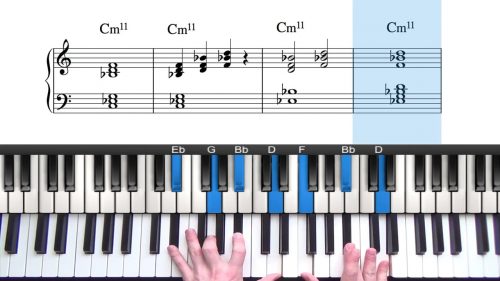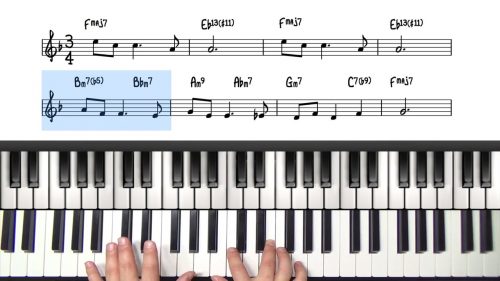Upper Structure Triads Piano Tutorial
Upper structures, also called upper structure triads, are triads that have been superimposed above a tritone. Upper structure triads are predominantly used on dominant chords but can also be applied to other chord types. In this lesson we’re just going to focus on dominant uppers structures triads.
Incorporating upper structures into the tunes you play will really take your playing forward and make your dominant chords sound much more interesting and sophisticated.
From a practical standpoint, upper structures allow you to easily remember voicings for complex altered sounds in all 12 keys. Ultimately, thinking of the lower and upper structures of the chord separately provides a shortcut as our brains have to process less pieces of information to get the same chord.
What Are Upper Structure Triads?
Upper Structure Triads are complex altered dominant chord voicings. The core components of an upper structure triad is the tritone interval in the left hand and a triad in the right hand which outlines the altered and extended tones of the dominant chord.
The lower structure of the chord always contains a tritone interval. This tritone interval in the left hand is what gives the chord its dominant quality. The lower structure is illustrated on the bottom stave.
The triad in the right hand is what’s referred to as the ‘upper structure’ of the chord. The upper structure is used to add a specific colour to the chord
The first chord is the tritone of C7 in the left hand and a Dmaj triad in the right hand. This gives us a dominant 13 #11 sound
Why do we split the chord into 2 parts
Now aside from the fact that they sound fantastic, there is reasoning behind the use of upper structures. By looking at the upper structure of the chord separately, we can simplify complex altered dominant chord voicings and internalise the extensions and alterations that are achieved from triads built of certain scale degrees.
From a practical standpoint, upper structures allow you to easily remember voicings for complex altered sounds in all 12 keys.
For example when you see a chord symbol for a C7alt chord, it will take you a moment to think "right, altered means #9 b13 so that means I need to raise the D to D# and flatten the A to Ab" , whereas, if you know that playing a major triad off the b13 (or flat 6) also gives you those two alterations, you can get that altered feel to the chord quickly and easily.
So to summarise, instead of having to think of each extension or alteration individually, we think of certain triads which we know contain those tones.
Ultimately, thinking of the lower and upper structures of the chord separately provides a shortcut as our brains have to process less pieces of information to get the same chord.
Rules of Upper Structure Triads
-
The tritone interval in the left hand can be played in either inversion — where you’re coming from and where you’re going will determine the best inversion to use to ensure smooth voice leading.
-
Avoid doubling the 3rd and 7th of the chord in the left hand. These tones do not need to be doubled as it is already a very harsh, dissonant sounding interval.
-
You don’t have to just play the 3rd and 7th in the left — other variations include
- R, 3, 7
- R, 7
- R, 5,7
However be aware that if you are playing with a bass player they will have the root covered.
-
You can double notes at the top or bottom of the upper structure — this will always sound good and adds more of a punch to the chord. Doubling the melody note at the bottom of the upper structure triad will also accentuate the melody.
-
Upper structures sound the strongest when the triad is played in its second inversion . This doesn’t mean that you are restricted to this inversion but be aware that this will create the strongest sound.
-
It can also be a nice effect to cascade down the inversions of the upper structure using the different inversions.
- You are not restricted to just one upper structure – Also sounds good if you play multiple triads on top of the tritone in close succession. Moving from #5-#9 to b9-#11 is actually a very common movement as you hear all of the possible alterations (b9, #9, #11 and #5 which is enharmonically equivalent to b13).
Lesson Downloads
-
Upper Structure Cheat Sheet File Type: pdf
-
Upper Structure Triads Lesson Notation File Type: pdf
-
Jazz Voicings Cheat Sheet File Type: pdf
Practice Tips
Don’t feel you need to use upper structures on every dominant, this will likely sound too rich. Just sprinkle them in here and there and mix up with lighter, sparser dominant voicings.
Always remember variety is the key. Upper structures are complex and dissonant voicings, but that doesn’t mean they sound good on every dominant chord you come across.








Hello. Nice video!
On the “Upper structures intro” pdf file, on the 43 measure (bar), on the bass clef, it is written a “A” could it be “G”.
Also, on the bar 44, on the treble clef, it is written C7b9#11, but is written a “D” could it be Db.
Hey Ioannis, thanks again for spotting these 😊
I have corrected both and re-uploaded the amended version.
Cheers,
Hayden
You are welcome.
Hello. Please recheck the corrections above from giannismusicsays. They do not appear to be fixed on the video. Thanks.
Hello, nice video.
On the “Upper Structures intro” pdf file, on the 14th measure, is written “so here are 5 upper structures than can be used over a C7 chord”.
Upper structure on 16th measure, us b3, is not written on the Upper Structure Triads, cheat sheet & formulas, pdf.
There is 4 not 5 formulas.
Hi Ioannis,
Yes there are hundreds of different upper structure triads. This lesson and the downloads were later simplified to make the lesson more accessible and digestible.
The 4 on the cheat sheet are by far the most useful and practical. Just with those 4 upper structures, they will have you covered when the melody note is any of the alterations (b9, #9, #11, #5/b13) and also the 3, b7 and 9.
Initially there were 7 formulas included on the cheat sheet but this caused more confusion and less focus for students so it was reduced the the 4 ‘essential’ UST formulas.
If you are new to this material, the main priority should be to learn and master those 4 upper structures.
The potential scope of upper structure study is huge. When you include diminished and augmented triads, you will have an endless list of variations. For the beginner student, this can be overwhelming and not a productive exercise.
My recommendation would be to learn the 4 formulas on the cheat sheet and apply them in context of jazz standards so that you develop a practical understanding. That in itself is no small task. The key is memorising them is to apply them in context, the formulas will then stick in your brain.
I find that with just those 4 upper structures, it gives me access to any altered sound that I want to create over a dominant chord.
Hops this helps Ioannis :-)
Cheers,
Hayden
Thank you.
Hello Hayden.Can i play 3 5 and 7 on the left hand?Or a complete cm7 dominant chord 1 3 5 7?
This lessons seems complicated but you explained it very well…now i understand perfectly what an upper structure is…gonna print the cheat sheet soon…thks
Glad you enjoyed the lesson Ivan. Yes the cheat sheet download is invaluable when learning this material. Print it off and stick it close to your piano. Cheers, Hayden
Hi Hayden – getting a bit overwhelmed :) Wish to ask where I can find the pdf notation for 9th, 11th and 13th chords for all keys? Big thanks in advance!
Thanks! So very helpful to think in terms of triad on top.
BTW, I think there’s a transcription error at about 11:00– 2nd bar, C7(#11/b9). All 3 notes should be flat right?
Hi Tom,
Yes that is correct, all 3 notes should be flat in the notation. Thanks for letting me know about this and I will fix it shortly. If ever in doubt, follow what is being played/demonstrated on the piano/light-up keyboard.
Yes it’s very useful to think of chords as an upper and lower structure, here are some more lessons and seminars which you will find useful on this topic:
pianogroove.com/live-seminars/understanding-upper-structure-triads/
pianogroove.com/jazz-piano-lessons/what-are-upper-structure-triads/
pianogroove.com/jazz-piano-lessons/upper-structures-practice/
Cheers,
Hayden
How do you get on to lesson 4 of upper structures
Hi Heather,
Please excuse my late reply here.
If you click back to the course page (pianogroove.com/jazz-piano-lessons/altered-harmony-upper-structure-triads) you will see all of the lessons in the course, and they are designed to be studied in the order listed. The course page name/link is shown above the top left corner of the any video/lesson page in green text, and this is clickable to take you back to the course.
You can also use the website search box to find related lessons, for example: pianogroove.com/?s=upper+sturcture – this is useful because it will give you a list of lessons, seminars, and courses (both theory lessons and jazz standard lessons) which incorporate upper structure triad theory.
I hosted a seminar on upper structures in March which you might like to check out here: pianogroove.com/live-seminars/ust-drills-easy-to-advanced/ – this is one of my latest explorations of the topic.
I hope that helps Heather, and please let me know if I can be of further assistance.
Best,
Hayden